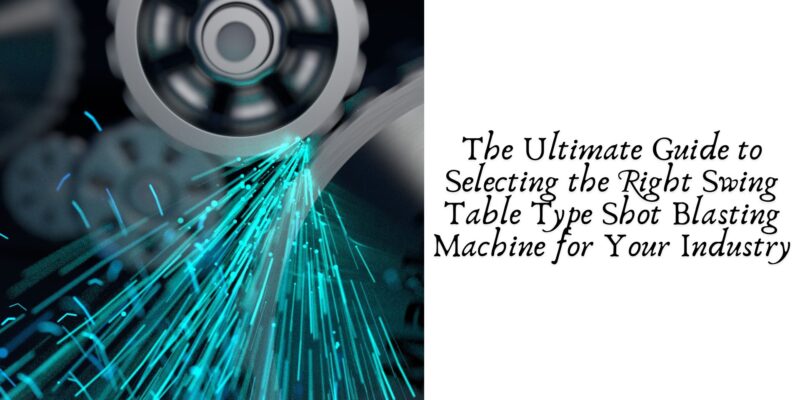
Shot blasting is a critical process in various industries, from automotive and aerospace to construction and foundries. It is used to clean, strengthen, and prepare surfaces for further treatment or coating. Selecting the right shot blasting machine is essential to ensure optimal results, efficiency, and cost-effectiveness. In this comprehensive guide, we will focus on swing table type shot blasting machines and how to choose the best one for your specific industry and application.
Understanding Swing Table Type Shot Blasting Machines
Swing table type shot blasting machines are designed for high-volume, continuous processing of small to medium-sized parts. The machine consists of a blast chamber, a rotating table, and a media propelling system. Parts are loaded onto the table, which swings into the blast chamber where they are exposed to a high-velocity stream of abrasive media. The table then swings out of the chamber for unloading and reloading.
Key advantages of swing table type shot blasting machines include:
- High throughput and efficiency
- Uniform coverage and consistent results
- Automated operation with minimal manual intervention
- Versatility in handling different part sizes and shapes
Factors to Consider When Selecting a Swing Table Type Shot Blasting Machine
To select the right swing table type shot blasting machine for your industry, consider the following factors:
Part Size and Weight
The size and weight of the parts you need to process will determine the appropriate machine dimensions and table capacity. Ensure that the machine can accommodate your largest parts and has sufficient weight capacity to handle your heaviest loads.
Production Volume
Consider your current and future production requirements when selecting a machine. A machine with a higher table speed and shorter cycle times will be more suitable for high-volume production, while a smaller machine may suffice for lower volumes.
Abrasive Media
The type of abrasive media used in the shot blasting process depends on the material being treated and the desired surface finish. Common media include steel shot, grit, and ceramic beads. Ensure that the machine is compatible with your chosen media and has the necessary controls for media flow and velocity.
Blast Pattern and Coverage
Different industries have varying requirements for blast pattern and coverage. For example, the automotive industry may require a more aggressive blast pattern for removing rust and scale, while the aerospace industry may need a gentler, more precise pattern for delicate parts. Consider the adjustability of the machine’s blast wheels and nozzles to achieve the desired pattern and coverage.
Automation and Integration
In modern manufacturing environments, automation and integration are key to optimizing efficiency and minimizing labor costs. Look for machines with features such as automatic part loading/unloading, conveyor systems, and PLC controls. These features enable seamless integration with other equipment and processes in your facility.
Maintenance and Serviceability
Regular maintenance is crucial to ensure the long-term performance and reliability of your shot blasting machine. Consider the ease of accessing critical components, the availability of spare parts, and the manufacturer’s support and service network.
Industry-Specific Considerations
In addition to the general factors mentioned above, there are industry-specific considerations when selecting a swing table type shot blasting machine:
Automotive Industry
In the automotive industry, shot blasting is used for cleaning and preparing parts such as engine components, transmission parts, and suspension components. Key considerations include:
- High throughput to meet production demands
- Ability to handle large and heavy parts
- Aggressive blast pattern for removing rust, scale, and other contaminants
- Integration with other processes such as machining and painting
Aerospace Industry
The aerospace industry requires shot blasting for cleaning and surface preparation of critical components such as turbine blades, landing gear, and structural parts. Important factors to consider include:
- Precise control over blast pattern and intensity to avoid damaging delicate parts
- Compliance with stringent quality and safety standards
- Ability to process parts of varying sizes and geometries
- Integration with other processes such as non-destructive testing and coating application
Construction Industry
In the construction industry, shot blasting is used for preparing surfaces such as concrete floors, steel structures, and pipelines. Key considerations include:
- Portability and mobility for on-site applications
- Rugged construction to withstand harsh environments
- Adjustable blast pattern for different surface profiles
- Dust collection and containment to meet environmental regulations
Foundry Industry
Foundries use shot blasting for cleaning and finishing castings made of various metals. Important factors to consider include:
- Ability to handle high volumes of castings
- Compatibility with different types of media for specific metal alloys
- Automated material handling systems for efficient processing
- Robust construction to withstand the harsh foundry environment
Conclusion
Selecting the right swing table type shot blasting machine is crucial for optimizing your surface preparation processes and ensuring the quality of your end products. By considering factors such as part size and weight, production volume, abrasive media, blast pattern and coverage, automation and integration, and maintenance and serviceability, you can narrow down your options and choose a machine that best suits your industry and application.
Additionally, working with a reputable manufacturer or supplier can provide valuable guidance and support throughout the selection and implementation process. They can assess your specific requirements, recommend suitable machines, and provide after-sales service and technical support.
Investing in the right swing table type shot blasting machine can significantly improve your productivity, quality, and bottom line. With the information provided in this guide, you are well-equipped to make an informed decision and take your surface preparation processes to the next level.
Name: Process & System
Address: Modi House, Ground Floor, 14, Raja Naba Krishna Street, Kolkata – 700 005, WB, India
P.No.: 9051202216










